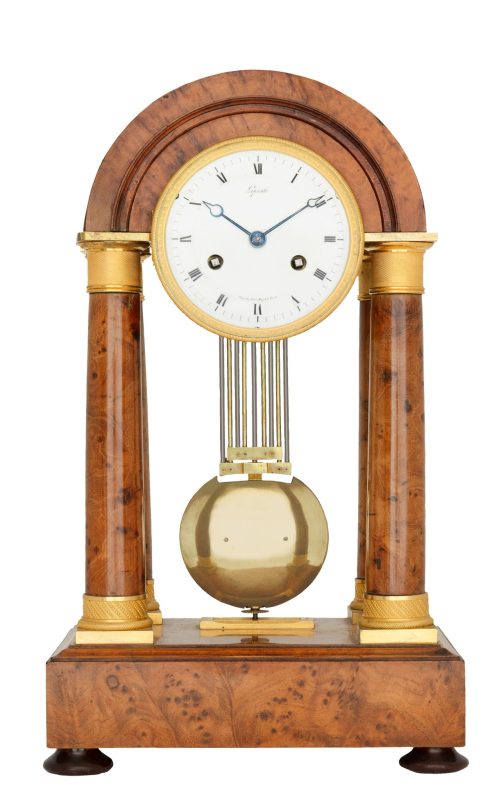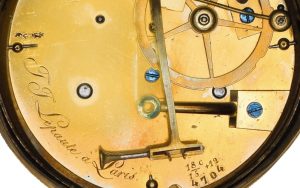Paris, around 1815
- signed
- "Lepaute, Place du Palais Royal à Paris" (dial) and "J. J. Lepaute à Paris 4704" (plate)
- Clockmaker
- Jean Joseph Lepaute,
- *1768 Bièvres, 1798-1811 cooperation with Pierre-Basile Lepaute (uncle), Horloger de l’Empereur (= Napoleon), 1811 Place du Palais Royal, 1821 Rue de Saint Honoré, 1821 Horloger du Roi
- Case
- polished poplar root wood veneer, engine turned ormolu mounts, ebonized bun feet
- Dial
- enamel
- Movement
- anchor escapement, gridiron pendulum with temperature compensation, knife-edge suspension, ruby bearing, half hour strike on bell with outside count wheel, duration of two weeks
- Height
- 13½ in
provenance: collection Prof. Dr. Hans von Bertele, Vienna
This important French precision clock from the renowned collection of Prof. Dr. Hans von Bertele is the work of the great Parisian master Jean Joseph Lepaute. The signature of the famous clockmaker can be found both on the enamel dial („Lepaute, Place du Palais Royale à Paris“) and on the plate („J. J. Lepaute à Paris“).
Jean Joseph is one of the most important representatives of the renowned Lepaute clockmaking dynasty. Born in Bievres (Ardennes) in 1768, he moved to Paris, where he worked with his uncle Pierre-Basile Lepaute from 1798 under the name „Lepaute Oncle & Neveu“. The successful duo was appointed Horlogers de l’Empereur – Napoleon’s clockmakers – and were honored with a gold medal at the Paris Industrial Exhibition in 1806.
In 1811, J. J. Lepaute founded his own branch on the elegant Place du Palais Royal. For Napoleon, he created luxurious timepieces for Fontainebleau Castle and the castles of Saint-Cloud and Compiègne. After the fall of Bonaparte, Lepaute continued to receive important commissions and was appointed Horloger du Roi (Louis XVIII) in 1821. In the same year he is listed with the address rue de Saint Honoré. The location of the signature „Place du Palais Royale“ therefore suggests that the present commode clock was made between 1811 and 1821.
The exquisite case, which Jean Joseph Lepaute chose for his masterful movement, has a classicist design, is covered with vividly grained poplar root wood veneer and is of clear elegance. Four delicate columns rest on the rectangular base with ebonized ball feet, supporting the movement case with its round-arched pediment. The finely engine turned ormolu bases and capitals of the columns as well as the dial bezel serve as the only ornamental decoration. The reduced forms of the case allow the sophisticated movement technology, in particular the pendulum with genuine temperature compensation, to be artfully showcased. The precision movement with anchor escapement and a long duration of two weeks is equipped with a half-hour strike on a bell.


